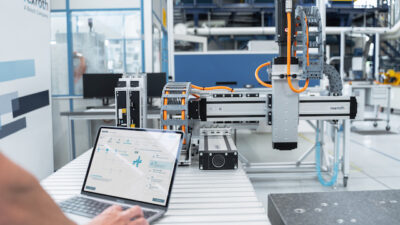Pneumatic-mechanical gripper benefits include large grip force range and easy implementation, which make them ideal for pick-and-place applications.
There are many applications that require picking and placing the same, or very similar, items consistently. If these items do not require force control in order to be safely picked, the pneumatic-mechanical gripper will often be the solution.
Pros for pneumatic-mechanical grippers include:
- Lower cost
- Fast acting
- Large grip force range
- Easy to implement custom fingers for application specific requirements.
Cons for pneumatic-mechanical grippers include:
- Limited variability in the size or shape of the part to be picked
- Limited force/position control capabilities
- Air needs to be supplied, prepped, and controlled with external valve.
The hypothetical application requires picking gear blanks that are coming down a conveyor and are being located at a precise point. The gear blanks are then being placed into a machine for a process. These gears are a standard product and this machine is dedicated to this gear blank size. The place point in the machine does not allow the gripper to grip on the outside diameter of the gear blank. The surface is not conducive for a vacuum gripper, and the material is non-ferrous, eliminating the possibility of a magnetic gripper.
One of the best remaining options would be to perform an internal diameter grip—or ID grip. The gripper provides opening force, which should be enough for the coefficient of friction given by using metal fingers to suffice. The downside to the increase in force is a shorter stroke. However, in this example the gripper will be picking the same part every time, which means the stroke will not be a concern. Custom fingers would be made for this application, potentially like the ones pictured below.
If needed, the fingers could be designed to incorporate a material with a higher coefficient of friction, thereby requiring a lower grip force to safely pick the gear blank.
Even though a pneumatic gripper may have limited stroke length, which can hamper its ability to pick a variety of parts, the ease of adding customized fingers allows it to pick items of complex geometry. To gain back some versatility, pneumatic grippers can be used in tandem with simple tool changers or quick change finger options to pick a variety of parts while still maintaining the low cost.
The pneumatic gripper is an optimal solution for a product line with the same picking feature. For those with a large range of picking features, or no picking features that would be conducive to gripping with fingers, please refer to my other related blogs to find the best solution.
Brant Bullister, mechanical design engineer, Cross Company, a CFE Media content partner. This article originally appeared on Cross Company’s robotics and machine automation blog. Edited by Chris Vavra, production editor, Control Engineering, CFE Media, [email protected].



